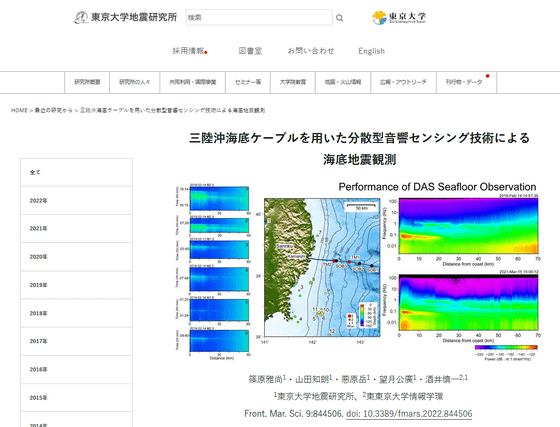Report of successful observation of cicada cicada calls using optical fiber

Optical fiber cables enable high-speed communications in daily life by literally transmitting and receiving light by reflecting it within the cable. However, small shocks and vibrations can affect communications, so research is underway to reverse this and use it to observe earthquakes and volcanoes. It has been reported that by using such an optical fiber cable, it was possible to observe the activity of cicadas, which numbered in the trillions for the first time in 17 years.
Long-term monitoring and analysis of Brood X cicada activity by distributed fiber optic sensing technology | Journal of Insect Science | Oxford Academic

Roar of cicadas was so loud, it was picked up by fiber-optic cables | Ars Technica
https://arstechnica.com/science/2023/12/roar-of-cicadas-was-so-loud-it-was-picked-up-by-fiber-optic-cables/
When a pulse of light is introduced into an optical fiber cable, the light is scattered by small amounts of impurities within the cable. Similarly, when vibration is applied to an optical cable, the cable deforms and the signal transmitted inside changes. Distributed acoustic measurement (DAS) is a system that measures ground shaking by measuring changes caused by this vibration.
Capturing vibrations with optical fibers | Tohoku University, Graduate School of Science, Department of Geophysics
https://www.gp.tohoku.ac.jp/research/topics/20210521155254.html

Because DAS captures small fluctuations in light, it is often used in recent years to monitor earthquakes and volcanic activity. For example, in Japan, research is being conducted to observe submarine earthquakes using DAS using submarine cables off the coast of Sanriku.
Undersea earthquake observation using distributed acoustic sensing technology using the Sanriku offshore submarine cable – Earthquake Research Institute, the University of Tokyo
https://www.eri.u-tokyo.ac.jp/research/16313/

In the spring of 2021, Sarper Ozerer, a physicist at NEC Laboratories in Princeton, New Jersey, noticed a strange noise in his DAS for observing volcanic activity. 'There were distinct frequencies buzzing everywhere that weren't supposed to be there,' Ozerer said.
Ozerer and his research team suspected that the source of the frequency was not a volcano, but a swarm of giant cicadas. In fact, 2021 was the year when trillions of cicadas, known as ``Brude X,'' appeared in large numbers every 17 years. The research team predicted that the chirping of these large numbers of cicadas caused vibrations that affected the DAS.
Cicadas have a space in their abdomen called a resonance chamber, and they make sounds by vibrating an organ called a 'sounding membrane' stretched there. Also, cicadas sing to reproduce, and only males sing. The research team believes that the large number of cicada calls may have caused enough vibrations to be detected by DAS.

So the research team contacted Jessica Ware, an entomologist and cicada expert at the American Museum of Natural History. 'I was observing cicadas and was in the Princeton area collecting biological samples,' Ware said. I was really excited when it showed that it actually corresponded to some degree with the pattern of occurrence.'
Furthermore, the research team noticed that there was a part of the telephone pole where the cable was rolled up into a loop. The influence of the received vibrations is amplified when the cable is looped than when it is straight, so the cable was able to receive the vibrations caused by the cicada's calls with higher sensitivity.

As a result of analyzing DAS data, it became clear from the signals picked up by DAS that cicadas hatch little by little, spawn in large numbers, reach a peak in population, and then decline after mating. The amount of noise made by cicadas is an indicator of the number of active cicadas. Therefore, if the size of the observed DAS varies depending on the location, we can also predict the size of the cicada population that was active in that area.
DAS data also revealed that changes in temperature and weather are affecting cicada activity. ``If you look at the five-day data, you can see that the frequency of the cry changes slightly in Hz as the temperature drops a little,'' Ware said.
The graph below shows the strength and weakness of the signal caused by cicada calls detected by DAS. It seems that heavy rain fell from June 11th to June 12th, and you can see that the signal from cicada calls suddenly weakened in the area marked with a red circle.

The research team says that this study shows the ``possibility of applying DAS to observe cicadas.'' By using standard fiber optic cables installed outdoors, it is possible to analyze cicada activity more quantitatively, and it is also possible to map cicada activity in real time along the route of the fiber optic cable. Masu. In addition, the research team will use optical fibers to compare the activities of cicadas over a wide range of areas, and future challenges will include whether it is possible to record the activities of a single individual over time via underground optical fiber cables.
'We use fiber optics to transport zeros and ones,' Ozerer said. 'But fiber optics can do so much more. Fiber-based DAS will become increasingly important in the near future. It will become more widely used.'
Related Posts:







